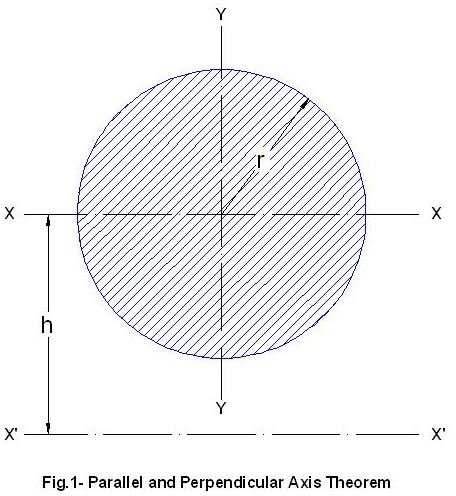Parallel Axis Theorem and Perpendicular Axis Theorem – Know How to Calculate Area Moment of Inertia about Any Axis
The area moment of inertia of irregular sections can be calculated using the basic area moment of inertia equation. On the other hand, the area moment of inertia of the regular sections about their axis passing the through centroid can be calculated using standard available tables. But if your mechanical design calculations require regular section’s area moment of inertia about any other axis, then you have to use either the parallel axis theorem or perpendicular axis theorem, or both, along with the standard table. We will use the figure below for the rest of our discussion:
Parallel Axis Theorem
From the standard tables you know that the area moment of inertia of the above circular cross section about the axis XX or YY can be written as:
Ixx = Iyy = (Π/4)*r4 ………….eqn.1.1
Now, if you need to calculate the area moment of inertia of the same circular cross section about the axis X’X’ then you cannot get a direct answer from the standard tables. You need some help from the parallel axis theorem. By using the parallel axis theorem you can calculate the area moment of inertia of the circular section about the axis X’X’ as below:
Ix’x’ = Ixx + A*h2 ……………eqn.1.2
Where,
A – Area of the section (here it is Π*r2**)**
Perpendicular Axis Theorem
Using the perpendicular axis theorem, you can calculate the area moment of inertia about an axis when the area moment of inertia about two other mutually perpendicular axis to that point are known.
Again, refer the Fig.1. You already know Ixx and Iyy as:
Ixx = Iyy = (Π/4)*r4 ………….eqn.1.1
Now, if you need to calculate the area moment of inertia about axis ZZ. Then according to the perpendicular axis theorem we can write:
Izz = Ixx + Iyy**…………………eqn.1.3**
So in our example,
Izz = (Π/4)*r4 + (Π/4)*r4
= (Π/2)*r4
Conclusion
Area moments of inertia about its centroid of the regular sections are available in standard tables. But many times you will come to the situation where you may have to calculate area moment of inertia about some other axis not passing through the centroid. The parallel axis theorem and the perpendicular axis theorem are useful for calculating area moment of inertia of such cases.
Related Readings
Calculate Area Moment of Inertia of Irregular Sections in Five Steps: This article will discuss the procedure to calculate area moment of inertia of different irregular cross sections.
